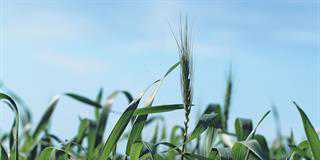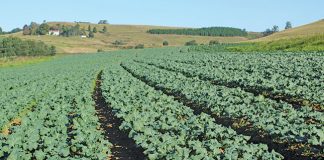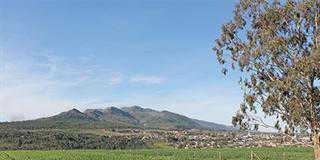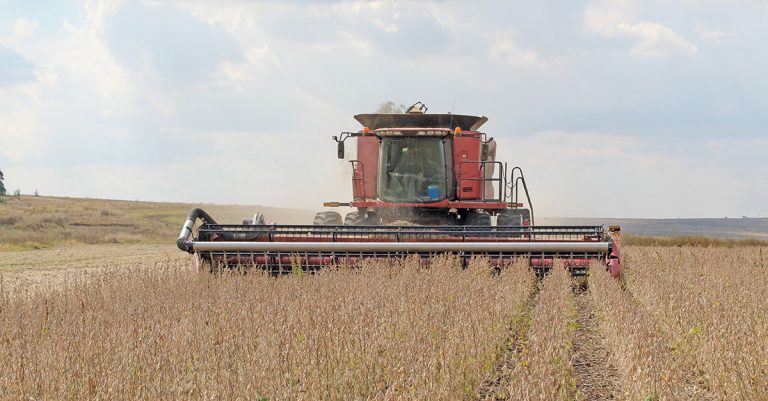
Photo: FW Archive
First-generation grain farmer Gerrie Schoeman from Ermelo, Mpumalanga, has experienced both the benefits and disadvantages of starting his farming business from scratch. Having to buy land and every last piece of equipment, from a claw hammer to a combine harvester, he has had to manage cash flow with great care to get on his feet.
Today, nearly seven years down the line, he has equipped his operation with the latest technology and applies precision farming techniques and strip-till (a combination of no-till and normal tillage) cultivation.
He spends hours researching the literature, speaking to farmers across the world, and keeping an eagle eye on his lands to work out the best possible solutions for his farm.
His efforts to improve his systems and management practices are paying off, with
this year’s crop looking particularly bountiful.
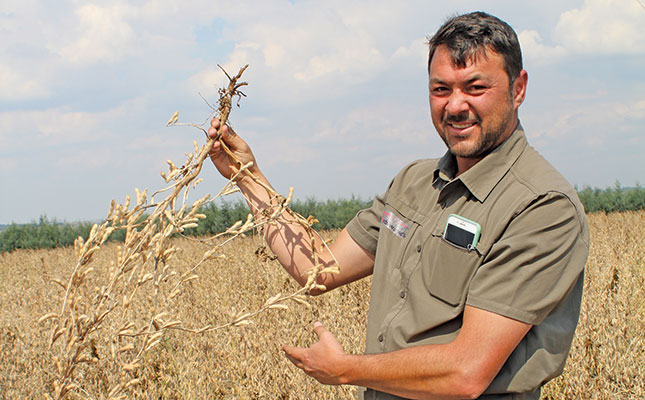
Improving the soil
Schoeman plants a third of his land to soya bean each year, rotating the lands with genetically modified (GM) and non-GM maize. Soya bean once made up half of his grain plantings, but with the increasing frequency of hailstorms in the area, Schoeman decided to reduce this component to lower his risk. Since maize is less susceptible to hail damage, he increased the area under this crop.
He uses strip-tillage to ensure minimum disturbance of the soil.
“I went over to strip-till five years ago, and while my yield took a dip in the first year, the soil has improved every year. The organisms in it are flourishing and the soil structure has improved. I anticipate that these benefits will continue to increase.
“I have very sandy soils, so the improved soil structure also results in less erosion, and my machines don’t get stuck in the lands as they used to do. I can start planting earlier because I don’t remove that last bit of moisture that’s still trapped in the soil, which would usually be released with ploughing. Strip-tilling also reduces run-off of inputs.”
Schoeman believes strongly in making the best use of time. He therefore hires expert consultants to do grid mapping of his farm and make precise recommendations, so that he can focus on the bigger picture of his operation.
Precision agriculture company SGS collects soil samples of the lands between June and September to determine the soil’s requirements. A precision map is then worked out with each hectare of land managed individually, according to its soil type and nutrient requirement. Schoeman uses AgLeader software to manage precision applications.
“The grid analysis gives me a complete picture of what’s happening on each hectare and how that piece of land must be treated. SGS analyses the results from the grid mapping and devises a plan for my applications, and I set the programs on my precision equipment accordingly,” he explains.
Lime and gypsum are then usually applied according to the requirements of each hectare. Schoeman, once again, uses contractors to do this and save himself time. The process is carried out after harvest (the busiest time of the year), and allows Schoeman to focus his attention on other areas of the farm.
Phosphate and potassium are also applied according to the soil’s requirements. Schoeman explains that phosphates must not be applied where lime has been added, as lime binds to the phosphate, rendering it useless to the plant. However, this aspect can easily be taken care of with precision technology.
Early planting
Schoeman plants the soya beans in the maize residue using a 16-row, 76cm Equaliser minimum-till precision planter. He aims for an early, short planting window between 25 September and 1 October.
“This is earlier than most other farmers, but I subscribe to the notion that ‘the early bean is the best bean’. Because it can get very wet here, with around 750mm of rain per annum, we need to start early to finish planting before the rain hinders us.
“Earlier planting means that the plants have extra time to grow and can take advantage of the extra sunlight during the crucial growing period in peak summer. It’s also important that the soya plants are bigger and stronger when the big rain arrives in December, otherwise they’d drown.”
Schoeman says that staggered planting in previous seasons proved his theory. Two soya bean lands were planted 20 days apart, and the yield of the first land was 1t/ ha higher than that of the second.
“At an average price of R7 500/t, that’s a huge difference. I intend investing in another planter this year so that we can complete planting on all our lands as early as possible.”
Schoeman varies planting density according to cultivar and soil type. He averages 300 000 plants/ ha with the cultivars Santa Rosa 565 and Pioneer P64T39. These were selected for their performance, with the former being especially resistant to eelworm, which he struggled to control previously. He achieves an average yield of just over 3t/ha.
Optimal nutrition
Schoeman pays close attention to microelements once the macroelements are all in balance.
“I apply a wide spectrum of microelements at different stages of plant growth, as and when they’re needed by the crop. At the V4 plant growth stage, I apply a large range of elements based on leaf analysis, which I carry out every two weeks. I also find that boron and calcium in particular make a big improvement, and I usually do an application at the R1 growth stage.”
Schoeman does not apply nitrogen to the soya crop, as he maintains it results in a “lazy” plant.
“I’ve been doing a good deal of research on nitrogen use on soya crops, and what successful US soya farmers like Randy Dowdy say resonates with me. They don’t believe in nitrogen applications because soya produces enough of its own nitrogen.”
Applying it from an external source discourages the plant from producing its own.
“I’m doing a trial with ammonia sulphate, as I’ve seen other farmers achieve success with it when applied after the plant has started making pods. But urea and normal nitrogen haven’t performed for me, so I stay away from them.
“This is also why I focus on microelements to boost the plant into making its own nitrogen-producing nodules. I use Stoller’s Bioforge and apply molybdenum at V4 and R1 plant growth stages.”
Schoeman is also experimenting with potassium applications.
“Based on the precision analysis and conversations with other farmers, I’ve started to notice that the traditionally advised applications of potassium are far lower than they should be. South African literature speaks of 4t/ha to 5t/ha, whereas US literature recommends double that.
“There are farmers in the region that have started using the US approach, but I’m nervous because of the high salt concentration of potassium. Next season, I’ll look at potassium sulphate and not potassium chloride, as the sulphate component is more beneficial to the plant, and it doesn’t have the high salt content.”
Precision farming
Schoeman aims for a soil pH of 5,5. Soil types vary widely across his lands, which is why precision management has been all the more beneficial for him.
“I started applying precision farming practices three years ago, and although there isn’t much difference in yield at this stage, I’ve seen the difference in my profit margins. I don’t waste inputs where they’re not needed, and that which is applied gives me a return on my investment.
“Seed, fertiliser and all input other costs have been reduced. In the past year alone, I saved 5,3% on input costs.”
Schoeman says that three pieces of equipment are essential to his operation: the 16-row, 76cm Equaliser minimum till precision planter, an Amazone ZA-TS mounted fertiliser spreader, and a Case Patriot self-propelled sprayer.
“With the sprayer, I can do applications quickly and efficiently. This is especially important if the leaf analysis indicates a nutrient shortage and I need to get to all the soya lands in a short time, so that the yield isn’t affected negatively from the shortage. Timing is crucial; I can’t take days to get through everything. Buying this machine was the best decision I’ve made.”
Liquid fertiliser is applied through the Equaliser. Schoeman prefers a liquid to granular application, as he can accurately measure the flow of the liquid and how much is applied.
The tractors communicate with each set of equipment through ISOBUS, so Schoeman need only input his programme and the technology ensures that each land gets what it requires.
He believes in sticking to a schedule and carrying out a task properly when doing it for the first time. This approach has stood him in good stead, and combined with his focus on precise management, is likely to result in further improvements.
Email Gerrie Schoeman at [email protected].











